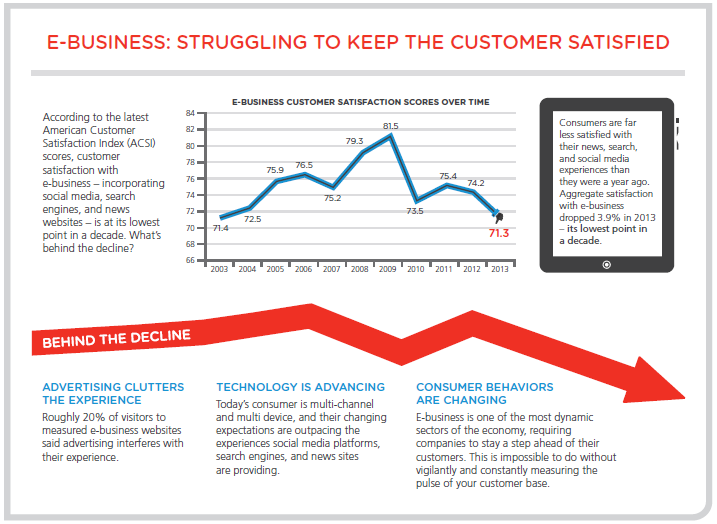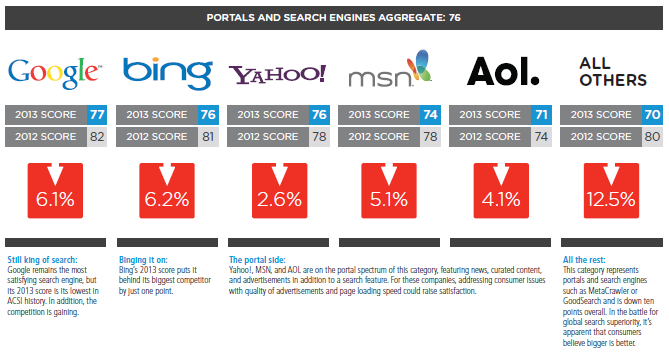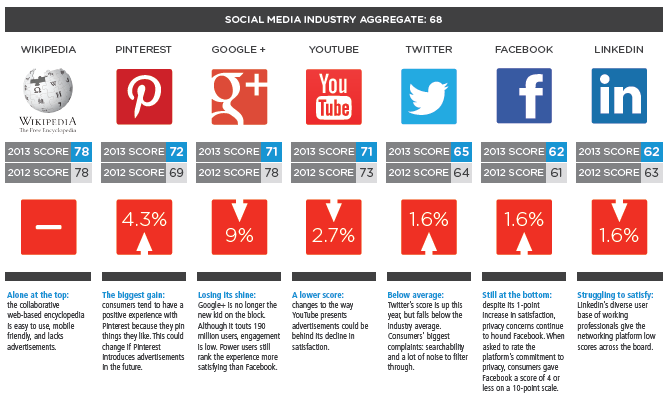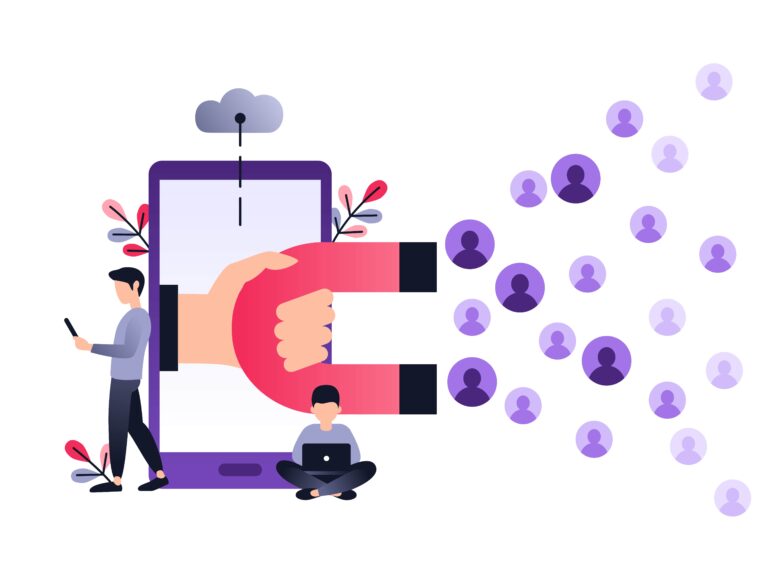A newly released study by satisfaction analytics company ForeSee shows that search engines and social media sites received lower satisfaction rates this year compared to last year. E-business satisfaction has dropped by 3.9% overall, receiving its lowest rate in a decade. The study alludes to the “growth and proliferation of advertising” as the main culprit behind this drop, among others.
Google Still Leads Despite Lowest Rating in a Decade
The study shows that overall user experience satisfaction with search engines and other information portals declined this year compared to last year, with Google falling 6.1% from 82 to 77. This is the lowest rating the search engine has received since 2003.
Despite the fall in satisfaction rating, it still is the most satisfying search engine, setting a new record for holding 25% of the U.S.’s Internet traffic and still commanding two-thirds of the online market share. The study also shows that 47% of the respondents use Google almost exclusively, and conduct 76-100% of their searches on the site. Competitors Bing and Yahoo! are close behind, each receiving a score of 76.
According to the study, 22% of the survey respondents blamed the quality of advertisements they were seeing on search engines for their dissatisfaction, with the next reason being slow page loading time (15%). The respondents said unsolicited advertisements were distracting.
Ads Impact Social Media Satisfaction
Despite the popularity and influence of social media in the online world, its satisfaction scores dropped in general, with Pinterest being the only social media site to gain points. The main reason behind the decline in social media satisfaction is “noise” – having to filter through unsolicited advertising (which keeps most of these social media sites free) and irrelevant posts before getting to the information they want.
The study also reveals the following:
- Over 50% of visitors to social media sites do not pay attention to ads
- 19% of users say ads interfere with their user experience
- Facebook has the highest percentage of users annoyed with ads (27%), followed by LinkedIn and YouTube (23%). Twitter had the least complaints, with only 12% saying ads interfere with their experience.
- Wikipedia and Pinterest lead the social media sites because they filter out advertising. The websites that received the most complaints do not have a filter in place, mixing posts and ads together and making it difficult for users to find information more quickly.
- Google+ is the only social media platform where users pay attention to advertising
What This Means for You as an Online Marketer
Search and social are two major channels for online advertising. Understanding consumer behavior and satisfaction on these two platforms lets you modify your approach to using them for your marketing campaign. Let’s go over the main takeaways from this study:
- Google is still the leading search engine. Satisfaction ratings may have dropped, but Google’s reach is more widespread than ever. Being seen on Google SERPs is the first step to reaching your target market effectively. Restaurant owners, for instance, should start diving into local SEO for restaurants to ramp up their online presence and take their restaurant business a step closer to their customers.
- Relevancy makes the difference. The dissatisfaction ratings came from irrelevant ads and content showing up on social media and search. Creating a sound content strategy focused on drawing inbound traffic requires that you know your audience and produce different types of content for them. This ensures your customers find the right kind of information on your pages when they search, whether on social media or on search engines. As proven by Google+ ads, they will offer their attention and click if your content is relevant to their search.
- Storytelling, not advertising. Apart from providing the right materials where they are relevant, you also need to consider how people react to the information they access. Your audience wants to read something unique, something they can relate to, and something that moves them to action. Direct advertising may not be the best approach for your campaign, especially if you are promoting your client’s brand through social media, where advertising is proven ineffective. You’ll need to tell stories, and use search and social hand-in-hand for funneling leads. You can start by reading a previous post I’ve written about creating a content strategy to build your brand.
Ensure your campaigns remain relevant to your target audience with our private label reseller program. Contact your account manager or sign up and become our partner to get started. Keep checking back for more industry updates and tips!




